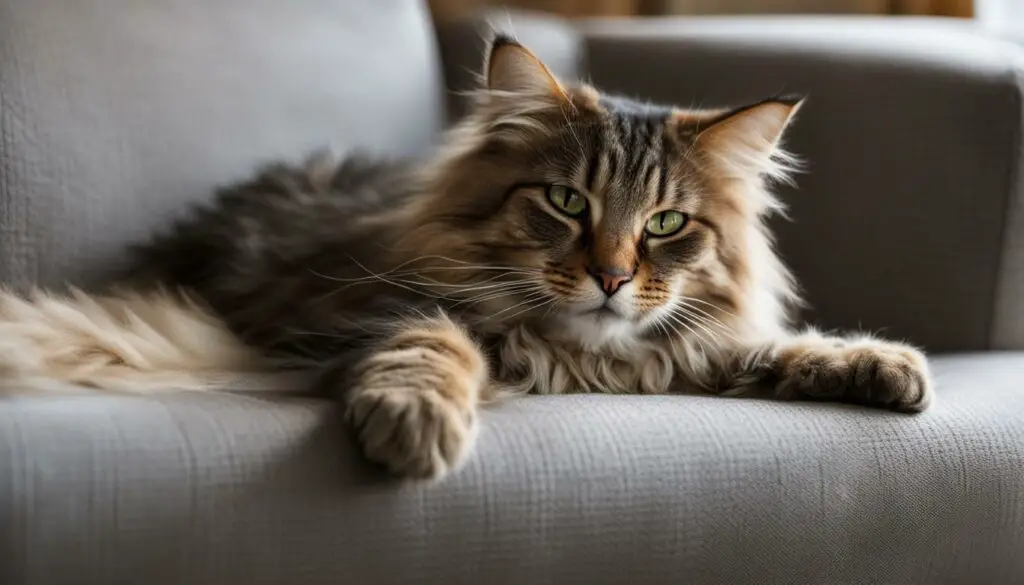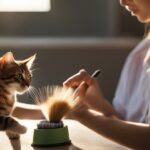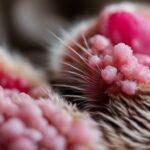Have you ever wondered why your cat insists on licking the couch? It’s a common behavior among feline friends, but excessive licking could be a sign of an underlying issue. In this article, I will delve into the reasons behind why cats lick the couch and provide insider tips on how to manage this behavior effectively.
Key Takeaways:
- Cats lick the couch for various reasons, and it is usually a normal behavior.
- Excessive licking could indicate stress or anxiety in cats.
- Grooming, territorial marking, seeking attention, and stress are common motivations for couch licking.
- Understanding the reasons behind cat licking behavior can help owners address it appropriately.
- If excessive licking persists or leads to skin problems, seeking veterinary evaluation is crucial.
Reasons Why Cats Lick the Couch
Cats may lick the couch for various reasons. Understanding these different motivations can help cat owners address the behavior appropriately. Here are some common reasons why cats lick the couch:
- Grooming: Cats are known for their grooming habits, and licking the couch can be a form of grooming behavior. They may be trying to clean themselves or remove any dirt or odor from the couch.
- Territorial marking: Licking the couch can also be a way for cats to mark their territory. Cats have scent glands on their cheeks, feet, and tails, and by licking objects like the couch, they leave their unique scent as a way to establish ownership.
- Seeking attention: Some cats may lick the couch as a way to seek attention from their owners. They may want to engage in social interaction or bonding through grooming behaviors.
- Stress or anxiety: Excessive licking of the couch can be a sign of stress or anxiety in cats. When cats feel overwhelmed, they may engage in compulsive behaviors like excessive licking as a way to cope.
Understanding these reasons can help cat owners determine if there are any underlying issues causing the licking behavior. It is important to observe your cat’s behavior and provide appropriate care and attention to ensure their well-being.
Grooming Behavior in Cats
Cats are natural groomers and spend a significant amount of time each day cleaning their fur. This grooming behavior is essential for maintaining hygiene, distributing natural oils, and removing loose hair. Licking the couch could be an extension of this natural grooming behavior.
Territorial Marking in Cats
One possible reason for cats licking the couch is to mark it as their territory. Cats have scent glands on their cheeks, feet, and tails, and by licking objects like the couch, they can leave their unique scent. This behavior is a way for cats to establish their ownership and mark their territory.
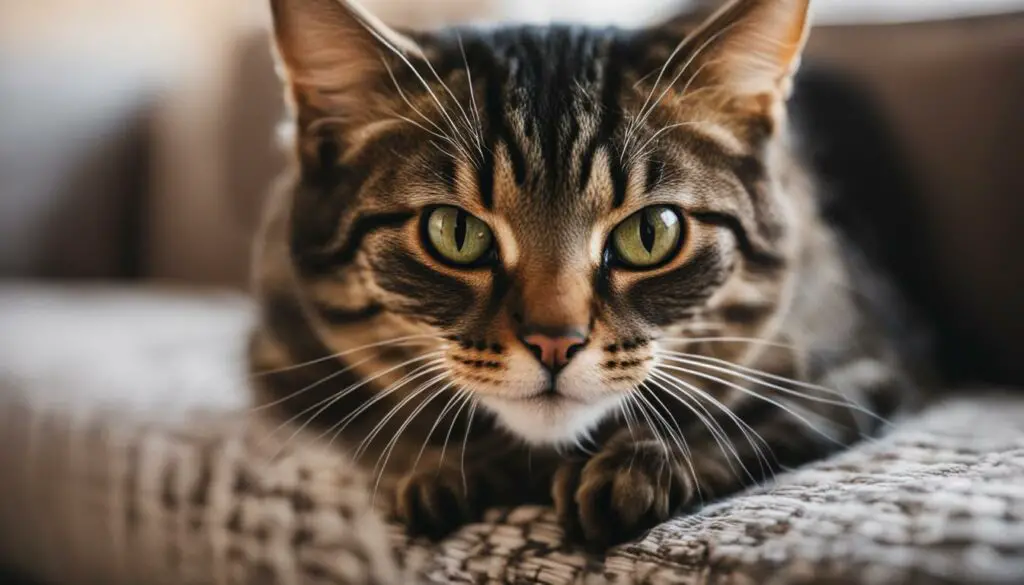
Seeking Attention Through Licking
Some cats may lick their owners or objects like the couch to seek attention. This behavior can be a form of bonding, as cats often groom their social partners. Licking can be a way for cats to engage with their owners and establish a closer relationship.
Grooming Behavior in Cats
Cats are well-known for their grooming habits, spending a significant amount of time each day meticulously cleaning their fur. This grooming behavior is not only a way to keep their coat clean and free of mats, but it also serves several important purposes in maintaining their overall health and well-being.
When cats groom themselves, they use their tongues to lick their fur, removing dirt, debris, and parasites. This self-grooming helps to distribute natural oils throughout their coat, which keeps their fur soft and shiny. Additionally, the licking action stimulates blood circulation, which promotes a healthy skin condition for cats.
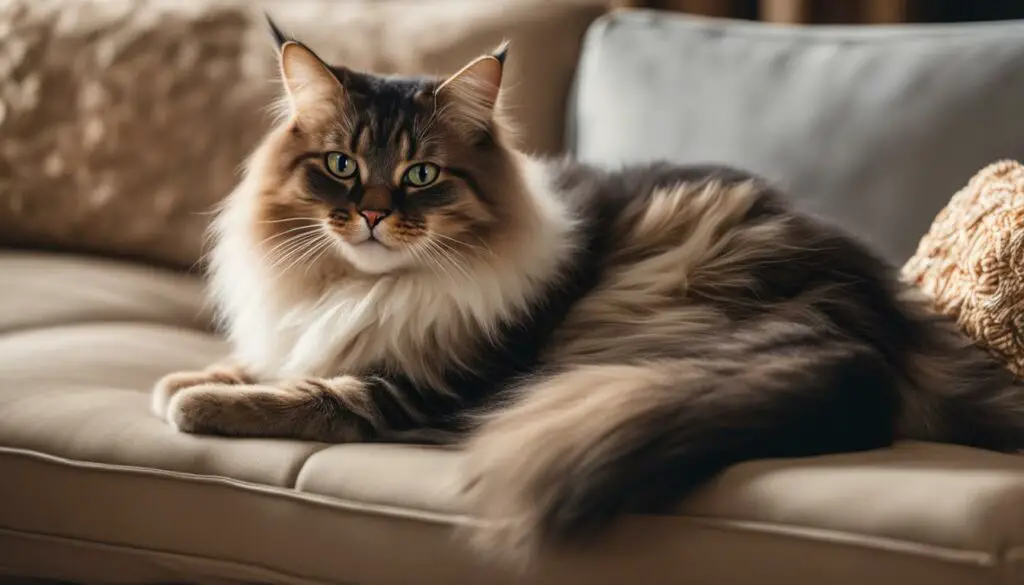
In some cases, cats may extend their grooming behavior beyond themselves and onto objects like the couch. This could be a way for them to transfer their scent onto the furniture, marking it as part of their territory. It’s important to note that this behavior is typically normal, but excessive grooming, including licking the couch, could indicate an underlying issue such as stress or anxiety.
Territorial Marking in Cats
Cats have a natural instinct to mark their territory, and one way they do this is through scent marking. This behavior is often exhibited by licking objects, including furniture like the couch. By leaving their unique scent on the couch, cats are communicating to other cats that this territory is theirs. It’s a way for them to establish their ownership and create a sense of security in their environment.
Cat scent marking is a common behavior observed in both male and female cats, and it can be influenced by factors such as hormones, social status, and the presence of other cats in the household. By understanding the reasons behind territorial marking, cat owners can better manage this behavior and create a harmonious living space for both their feline companions and themselves.
The Science Behind Cat Scent Marking
Cat scent marking is a complex behavior that involves the release of pheromones from the scent glands located on various parts of a cat’s body, including their cheeks, feet, and tails. When a cat licks an object like the couch, they are depositing these pheromones, which can only be detected by other cats. This communication method allows cats to establish boundaries, claim their territory, and convey information about their presence and status to other cats in the area.
It’s important to note that territorial marking is different from urine marking, which involves spraying urine on vertical surfaces. While both behaviors serve a similar purpose, scent marking is more commonly observed in cats who have not been spayed or neutered, as hormones play a significant role in its occurrence. However, even spayed or neutered cats can engage in territorial marking if they feel threatened or if there are changes in their environment that trigger this behavior.
To discourage territorial marking on the couch, cat owners can provide alternative outlets for their cat’s marking behavior, such as vertical scratching posts or designated areas where they can leave their scent. Additionally, ensuring a calm and stress-free environment, providing plenty of hiding spots and elevated surfaces, and allowing each cat in the household to have their own resources can help reduce the need for territorial marking.
| Pros of Territorial Marking | Cons of Territorial Marking |
|---|---|
| Allows cats to establish their territory | Can lead to conflicts with other cats |
| Helps cats feel secure in their environment | May result in damage to furniture |
| Communicates information to other cats | Can be difficult to remove the scent from furniture |
Overall, territorial marking is a natural behavior for cats, and understanding the reasons behind this behavior can help cat owners create a peaceful and harmonious home environment. By providing appropriate outlets for marking behavior, creating a stress-free atmosphere, and addressing any conflicts between cats in the household, cat owners can effectively manage territorial marking and ensure a happy and comfortable living space for their feline friends.
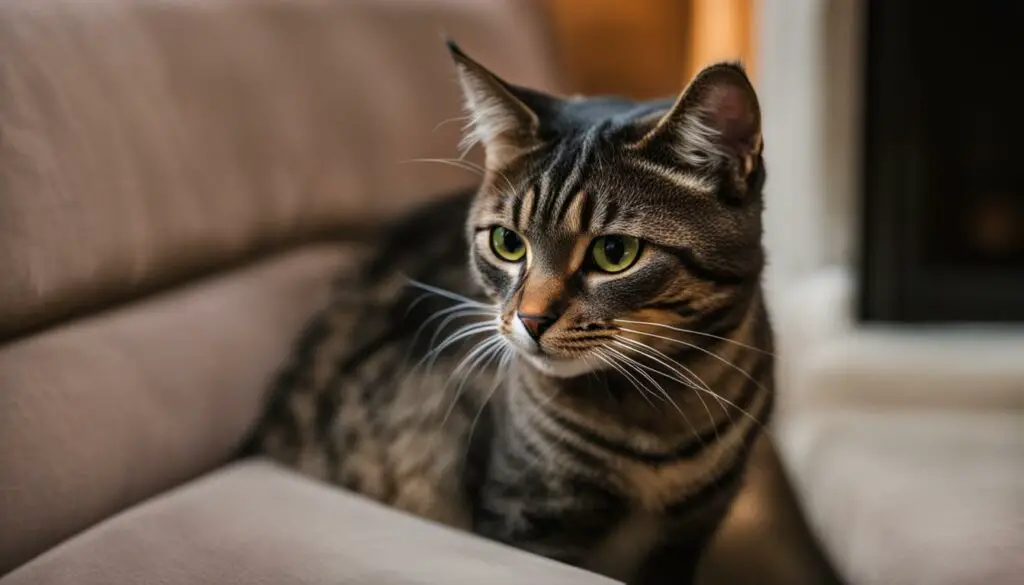
Seeking Attention Through Licking
Some cats may lick their owners or objects like the couch to seek attention. This behavior can be a form of bonding, as cats often groom their social partners. Licking can be a way for cats to engage with their owners and establish a closer relationship. Whether it’s gentle licks on your hand or a few strokes on the couch, these actions are their way of connecting with you.
But why do cats seek attention through licking? Cats are social animals, and they rely on social interaction for their well-being. Licking is a natural behavior that cats use to communicate and show affection. By licking you or objects in your home, they are expressing their desire for attention and connection. It’s their way of saying, “I want to be close to you” or “I feel comfortable and secure in your presence.
While attention-seeking licking is generally harmless, it’s important to set boundaries and understand your cat’s needs. If your cat is constantly demanding attention through excessive licking, it may be a sign of underlying stress or anxiety. In such cases, it’s essential to provide additional mental and physical stimulation to alleviate their need for attention. Interactive play sessions, providing toys, and creating a stimulating environment can help redirect their behavior and ensure they receive the attention they need in a healthy way.
“My cat loves to lick my face and hands whenever I sit down. At first, I thought it was strange, but my veterinarian explained that it’s her way of showing affection and bonding with me. Now, I see it as a special moment of connection between us.” – Cat owner
| Signs of Attention-Seeking Licking | Signs of Stress or Anxiety |
|---|---|
|
|
Understanding your cat’s attention-seeking behavior can strengthen your bond and provide opportunities for meaningful social interaction. However, it’s crucial to be aware of any signs of stress or anxiety and address them accordingly. By striking a balance between meeting their need for attention and ensuring their overall well-being, you can create a harmonious relationship with your furry friend.
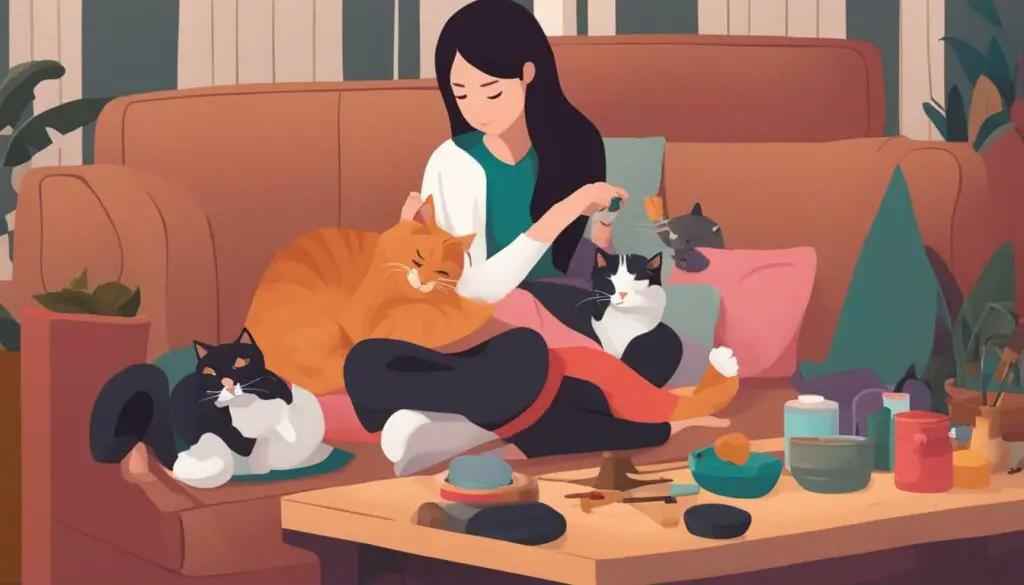
Licking as a Response to Stress
Excessive licking of the couch can be a sign that your cat is experiencing stress or anxiety. Cats, like humans, can become overwhelmed by various factors in their environment, leading to behavioral changes such as excessive grooming or licking. It’s important to recognize these signs of stress and take steps to alleviate them for the well-being of your feline companion.
Stress-related behavior in cats can manifest in different ways, and excessive licking is one common sign. When cats feel stressed or anxious, they may engage in compulsive behaviors like licking as a way to cope with their emotions. It’s crucial to observe your cat’s overall behavior and look for other signs of stress, such as hiding, refusing food, or having accidents outside the litter box, in conjunction with excessive licking.
To help your cat manage stress-related licking behavior, it’s important to identify and address the underlying causes of their stress. This may include providing a safe and comfortable environment, creating a routine, offering interactive toys and playtime, and ensuring they have a designated space for relaxation. However, if the excessive licking persists or worsens, it’s advisable to seek guidance from a veterinarian or animal behaviorist who can provide a comprehensive evaluation and recommend appropriate strategies or treatments.
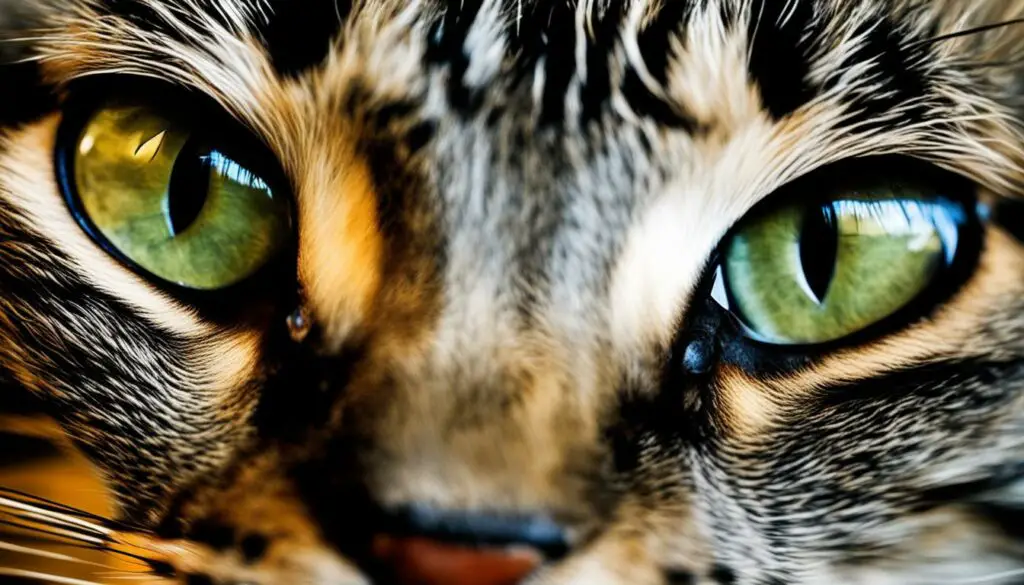
Table: Signs of stress in cats
| Behavior | Description |
|---|---|
| Excessive licking or grooming | Cats may excessively lick themselves, objects, or even their owners when stressed. |
| Hiding or withdrawal | Stressed cats may seek out hiding spots or become reclusive. |
| Changes in appetite | Stress can lead to a decrease or increase in appetite in cats. |
| Inappropriate elimination | Cats may have accidents outside the litter box when stressed. |
| Aggression or irritability | Stressed cats may display aggressive behaviors or become easily irritable. |
Early Weaning and Licking Behavior
Early weaning can have a significant impact on a kitten’s behavioral development, including the development of wool-sucking behavior. When kittens are separated from their mother prematurely, they may engage in sucking or licking behaviors as a way to cope with stress. This behavior is known as wool-sucking because it often involves kittens sucking or licking on soft objects such as blankets or wool.
Research suggests that the timing of weaning plays a crucial role in the development of this behavior. Kittens that are weaned too early, before they are fully independent, are more likely to exhibit wool-sucking behavior compared to those weaned at the appropriate age. This behavior is thought to be a self-soothing mechanism that kittens use to alleviate stress or anxiety in the absence of their mother’s presence.
To address wool-sucking behavior in cats, it is essential to provide them with alternative outlets for their need to suck or lick. This can include offering appropriate chew toys or interactive feeders that simulate the sensation of suckling. Providing environmental enrichment, such as vertical space for climbing, hiding spots, and scratching posts, can also help alleviate stress and reduce the frequency of wool-sucking behavior.
| Early Weaning | Behavioral Development | Wool-Sucking Behavior |
|---|---|---|
| Can impact a kitten’s behavioral development | Development of wool-sucking behavior | Sucking or licking objects as a coping mechanism |
| Separation from mother prematurely | Increase likelihood of wool-sucking behavior | Sucking or licking on soft objects |
| Timing of weaning is crucial | Provide alternative outlets for sucking or licking | Offer appropriate chew toys and environmental enrichment |
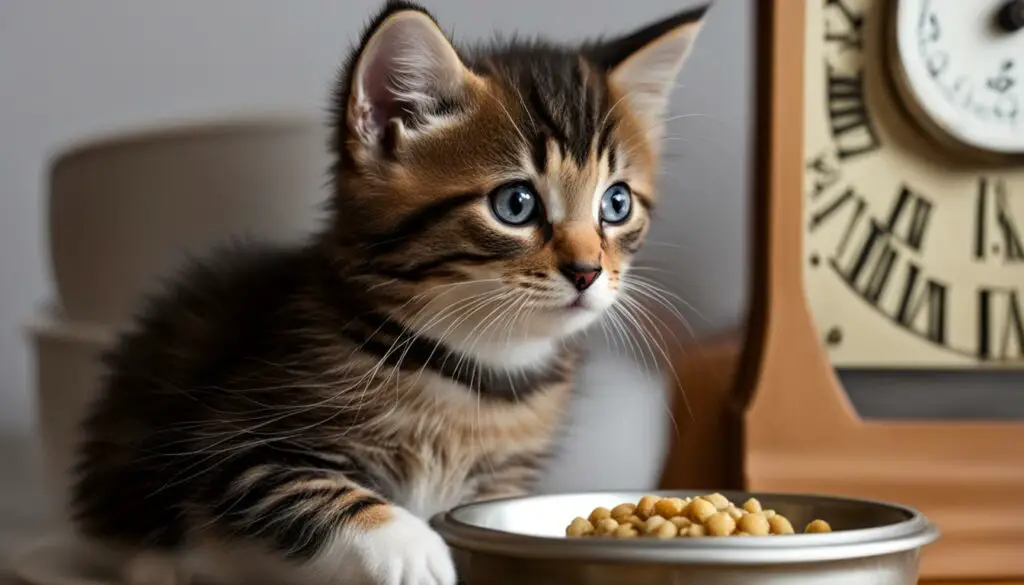
Note: The image above illustrates the delicate nature of early weaning and its potential impact on a kitten’s development.
Attention-Seeking Licking Behavior
In some cases, cats may lick their owners to get attention. This behavior is a way for cats to communicate their needs or wants. Whether it’s a request for playtime, cuddling, or an attempt to alert their owners to something, licking can be a form of cat communication. However, it’s important to pay attention to other signs of stress or discomfort in conjunction with licking behavior.
Signs of Stress in Cats
Cats may exhibit various signs of stress, including hiding, loss of appetite, aggression, excessive grooming, and changes in litter box behavior. If your cat’s licking behavior is accompanied by any of these signs, it’s crucial to address the underlying stressors. Creating a calm and enriching environment, providing plenty of playtime and mental stimulation, and ensuring a consistent daily routine can help reduce stress levels in cats.
Quote: “Attention-seeking licking behavior can be a way for cats to express their social and emotional needs. However, it’s important to ensure that the behavior is not a symptom of underlying stress or anxiety.” – Dr. Emily Thompson, feline behavior specialist
Cat Communication and Bonding
Licking can also be a form of bonding between cats and their owners. In the wild, cats groom each other as a way to strengthen social bonds. When a cat licks their owner, it may be a sign of trust and affection. In response, owners can show their appreciation by engaging in interactive play sessions, providing positive reinforcement, and offering plenty of physical and mental stimulation for their feline companions.
| Signs of Stress in Cats | Attention-Seeking Licking Behavior |
|---|---|
| Hiding | Licking owners to get attention |
| Loss of appetite | Request for playtime or cuddling |
| Aggression | Trying to alert owners to something |
| Excessive grooming | Form of cat communication |
| Changes in litter box behavior |
By understanding the motivations behind attention-seeking licking behavior, cat owners can foster a strong bond with their feline companions. It’s essential to provide a nurturing and stimulating environment while being attentive to any signs of stress or discomfort. If the licking behavior persists or becomes excessive, consulting with a veterinarian or animal behaviorist can provide further guidance on managing the behavior and ensuring the overall well-being of the cat.

Addressing Excessive Licking Behavior
Excessive licking behavior in cats can be a concern for many cat owners, as it may indicate underlying issues or discomfort. Fortunately, there are several strategies that can be implemented to manage and address this behavior effectively. By focusing on managing excessive licking, reducing cat stress, and implementing behavior modification techniques, cat owners can help their feline companions find relief and improve their overall well-being.
One important step in managing excessive licking behavior is to identify and address any potential sources of stress in the cat’s environment. This may include providing a calm and safe space for the cat, minimizing loud noises or disruptions, and ensuring regular access to essential resources such as food, water, and litter boxes. Creating a consistent routine and providing environmental enrichment activities can also help reduce stress and anxiety in cats.
Another approach to addressing excessive licking is through behavior modification techniques. These techniques involve redirecting the cat’s attention and providing alternative activities that are incompatible with licking. For example, engaging the cat in interactive play sessions, offering puzzle toys or treat-dispensing toys, and providing vertical spaces such as scratching posts or cat trees can help redirect their focus and energy.
Reducing cat stress is crucial
In some cases, seeking guidance from a veterinarian or animal behaviorist may be beneficial. They can provide further insights into potential underlying medical issues or behavioral concerns, develop a tailored treatment plan, and recommend appropriate medications or supplements if necessary. They can also offer guidance on positive reinforcement training techniques to reinforce desired behaviors and discourage excessive licking.
It’s essential to remember that managing excessive licking behavior may take time and patience. Consistency is key, and it’s important to monitor the cat’s progress closely. By addressing underlying causes, providing a stress-free environment, and implementing behavior modification techniques, cat owners can help their cats overcome excessive licking behaviors and improve their overall quality of life.
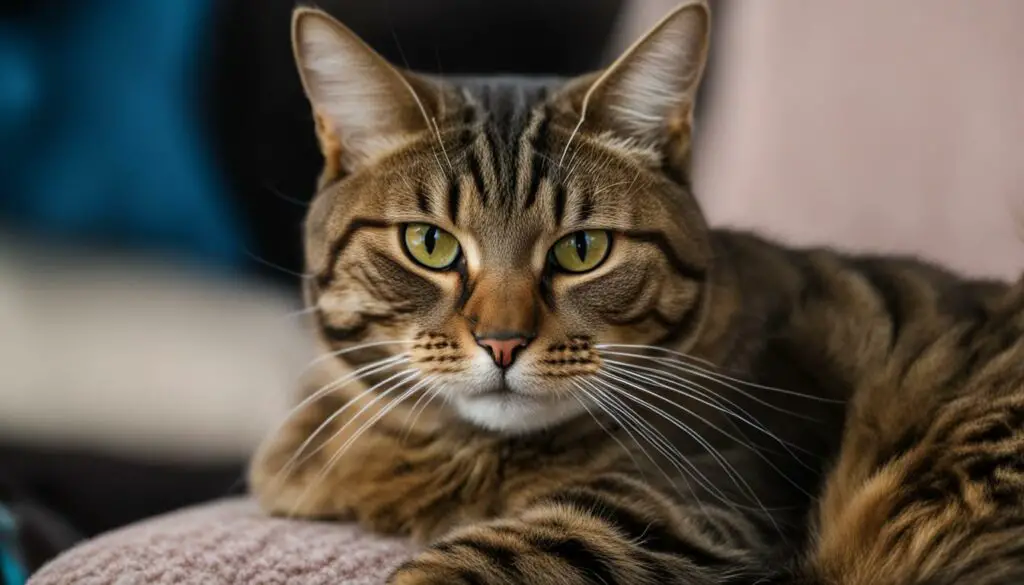
| Managing Excessive Licking Behavior | Reducing Cat Stress | Cat Behavior Modification |
|---|---|---|
| Identify and address sources of stress | Create a calm and safe environment | Redirect attention and provide alternative activities |
| Minimize loud noises or disruptions | Establish a consistent routine | Engage in interactive play sessions |
| Ensure access to essential resources | Provide environmental enrichment | Offer puzzle toys or treat-dispensing toys |
| Seek guidance from a veterinarian or behaviorist | Monitor the cat’s progress closely | Consider medications or supplements if necessary |
| Use positive reinforcement training techniques |
Cats Licking Other Objects
Aside from licking the couch, cats may also exhibit licking behavior towards other objects such as blankets and plastic. Understanding the reasons behind these variations in licking behavior can provide insights into our feline companions’ needs and preferences.
When cats lick blankets, it can be a soothing behavior reminiscent of their relationship with their mother as kittens. This gentle act mimics the comforting sensation of kneading and suckling, providing a sense of security and relaxation. Licking blankets may also serve as a self-soothing mechanism when cats are feeling anxious or stressed.
Licking plastic, on the other hand, can be a sensory or play-related behavior. The smooth texture of plastic may appeal to cats, stimulating their curiosity and providing a source of tactile stimulation. Some cats may enjoy the crinkling sound produced by licking plastic, finding it entertaining and engaging.
| Licking Blankets | Licking Plastic |
|---|---|
| • Soothing behavior • Reminiscent of their relationship with their mother • Provides a sense of security |
• Sensory or play-related behavior • Tactile stimulation • Entertainment and engagement |
It is important to note that while some licking behaviors may be harmless and natural, excessive or compulsive licking can indicate underlying issues such as anxiety or stress. If your cat’s licking behavior becomes problematic or leads to skin problems, it is advisable to consult with a veterinarian to rule out any medical conditions or behavioral concerns.
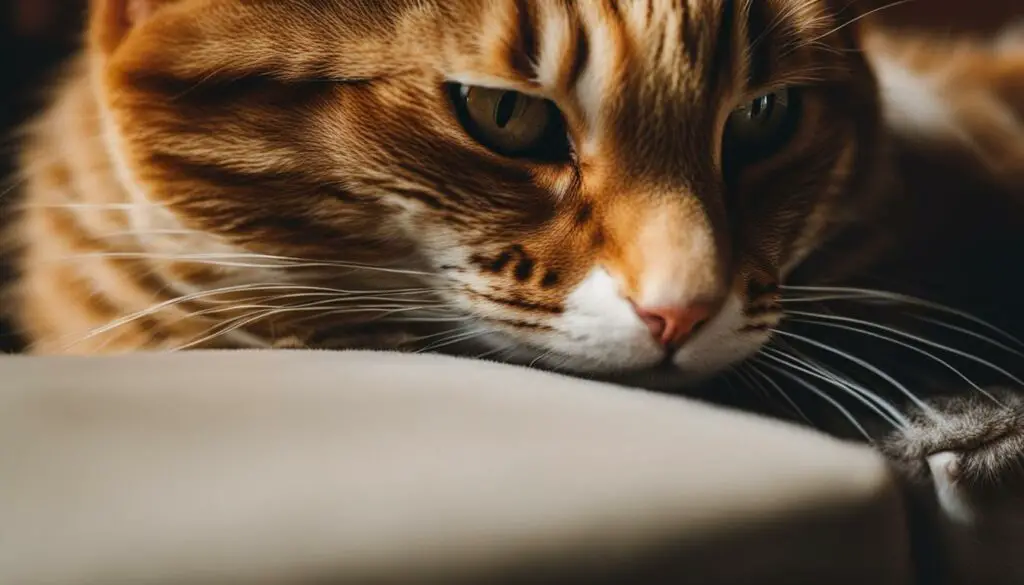
Wool-Sucking Behavior
Another form of licking behavior in cats is wool-sucking, which typically occurs in kittens that were weaned too early. This behavior involves sucking or licking on soft objects, such as blankets or clothing. Wool-sucking behavior is thought to be a coping mechanism for stress, as it provides comfort and a sense of security reminiscent of nursing from their mother. It is important to ensure that kittens are weaned at an appropriate age to minimize the development of anxious licking behaviors.
When to Seek Veterinary Evaluation
Excessive licking in cats can sometimes be a sign of underlying medical issues that require veterinary evaluation. If your cat’s excessive licking leads to bald spots, skin irritations, or other grooming issues, it is important to seek professional help. Your veterinarian can conduct a thorough examination and diagnose any potential health problems that may be causing the excessive licking behavior.
Cat health problems that can manifest as excessive licking include allergies, skin infections, and pain. Allergies can cause itching and discomfort, leading to excessive grooming. Skin infections can cause irritation and inflammation, prompting cats to lick excessively in an attempt to soothe the affected areas. Additionally, cats experiencing pain, whether from an injury or an underlying condition, may engage in excessive grooming as a form of self-soothing or as a response to stress.
By seeking veterinary evaluation, you can ensure that any underlying medical causes of excessive licking are properly addressed. Your veterinarian can recommend appropriate treatment options, such as medications for allergies or pain relief, and provide guidance on managing your cat’s grooming issues. Remember, early detection and treatment of medical conditions are crucial for your cat’s well-being.
Table: Common Medical Causes of Excessive Licking
| Medical Condition | Symptoms |
|---|---|
| Allergies | Itching, redness, skin irritation |
| Skin Infections | Redness, inflammation, sores |
| Pain | Limping, sensitivity to touch, behavioral changes |
Seeking veterinary evaluation is essential to ensure that your cat receives appropriate treatment for any medical conditions causing excessive licking. Addressing the underlying health problems can help alleviate your cat’s discomfort and prevent further grooming issues.

Treating Excessive Licking Behavior
When it comes to treating excessive licking behavior in cats, there are several options to consider. The approach will depend on the underlying cause of the behavior. If medical issues such as allergies or infections are identified as the culprit, it is important to address these issues first. A visit to the veterinarian can help diagnose and treat any medical conditions. In some cases, anti-anxiety medications may be prescribed to help reduce stress and calm the cat.
In addition to medical treatment, behavior modification techniques can be implemented to address excessive licking behavior. This may involve identifying and addressing any environmental stressors that may be triggering the behavior. Providing a safe and enriched environment that includes plenty of mental and physical stimulation can help alleviate stress and redirect the cat’s attention from excessive licking.
It may also be beneficial to work with an animal behaviorist who can provide guidance and develop a comprehensive treatment plan. This may include techniques such as desensitization and counterconditioning, which can help the cat associate positive experiences with alternative behaviors. By replacing the licking behavior with more appropriate activities, such as play or grooming with appropriate tools, the excessive licking can be gradually reduced.
| Treatment Options | Description |
|---|---|
| Medical Treatment | If medical issues are identified, such as allergies or infections, they should be addressed first with appropriate medication and treatment. |
| Behavior Modification | Identify and address environmental stressors, provide mental and physical stimulation, and work with an animal behaviorist to develop a comprehensive treatment plan. |
| Anti-Anxiety Medication | In severe cases, anti-anxiety medications may be prescribed to help reduce stress and calm the cat. |
Overall, treating excessive licking behavior in cats involves a multi-faceted approach that combines medical treatment, behavior modification techniques, and environmental enrichment. By addressing the underlying causes and providing appropriate care, cat owners can effectively manage and reduce excessive licking behavior in their feline companions.
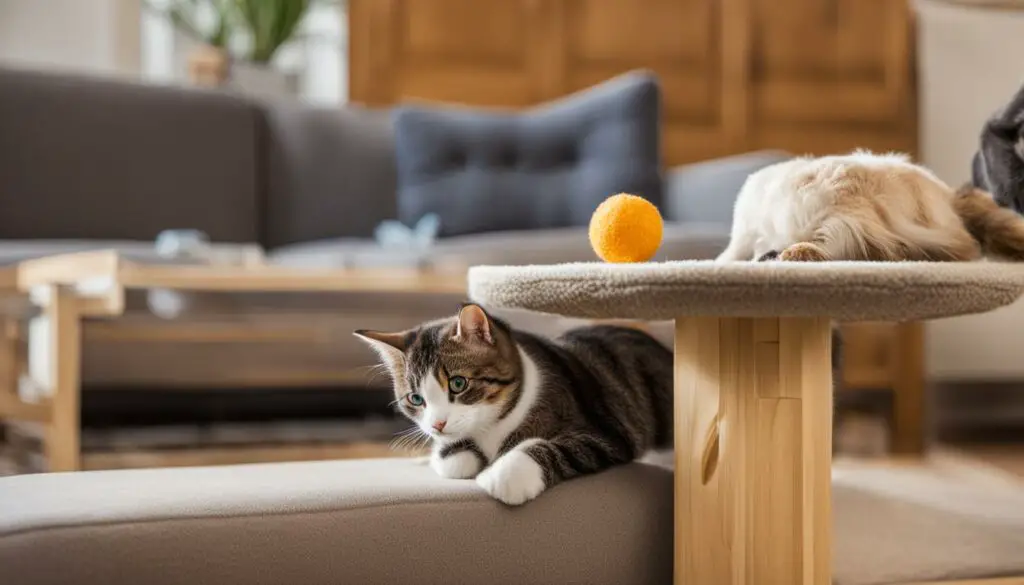
Preventing Excessive Licking Behavior
When it comes to preventing excessive licking behavior in cats, creating a cat-friendly environment that reduces stress and provides outlets for natural behaviors is key. By implementing the following strategies, you can help divert your cat’s attention from excessive licking and promote a happier, more balanced feline companion.
1. Environmental Enrichment
Providing your cat with plenty of mental and physical stimulation is essential for preventing excessive licking. Offer a variety of toys that mimic hunting behavior, such as puzzle feeders or interactive toys that dispense treats. Additionally, consider creating vertical spaces, such as cat trees or shelves, to give your cat opportunities to climb and explore. Engaging in regular play sessions with your cat can also help redirect their energy and prevent boredom-induced licking.
2. Stress Reduction
Cats are sensitive creatures that can easily become stressed in their environment. Identifying and minimizing sources of stress can help prevent excessive licking. Ensure that your cat has a quiet, safe space where they can retreat to when they feel overwhelmed. Consider using pheromone diffusers or calming sprays to create a soothing atmosphere. Maintain a consistent daily routine to provide a sense of security for your cat. If necessary, consult with a veterinarian or animal behaviorist to develop a tailored stress reduction plan for your feline friend.
3. Grooming and Positive Reinforcement
Regular grooming sessions can help satisfy your cat’s grooming needs and reduce the likelihood of excessive licking. Brushing your cat’s fur not only keeps them clean but also strengthens the bond between you and your pet. Use positive reinforcement techniques, such as treats or praise, to reward your cat for calm and relaxed behavior. By associating positive experiences with alternative behaviors, you can redirect your cat’s attention away from excessive licking.
By implementing these preventive measures, you can create a harmonious environment for your cat and reduce the likelihood of excessive licking behavior. Remember, if you have concerns about your cat’s licking habits, it’s always best to consult with a veterinarian to rule out any underlying medical conditions or discuss further behavior modification strategies.
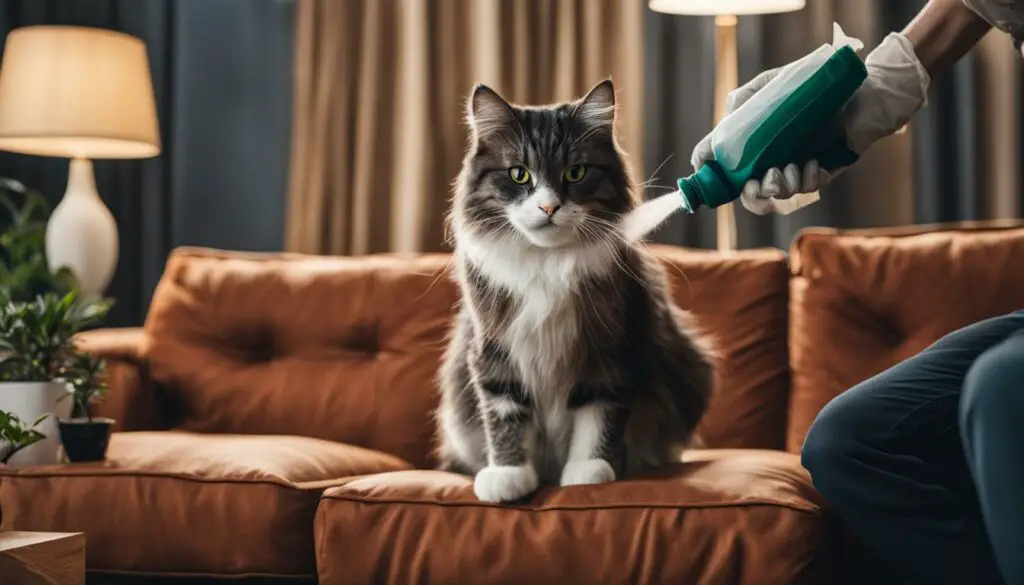
Conclusion
Understanding cat behavior is crucial when it comes to managing their grooming habits, including licking behavior. Cats may lick the couch for various reasons, such as grooming, marking territory, seeking attention, or as a response to stress. While occasional licking is normal, excessive licking could indicate an underlying issue that needs attention.
To effectively manage cat licking behavior, cat owners should address the underlying cause. This may involve reducing sources of stress, providing environmental enrichment, and seeking guidance from a veterinarian or animal behaviorist. By creating a cat-friendly environment and promoting overall well-being, cat owners can help their feline companions lead healthy and happy lives.
To understand cat behavior better, it is essential to recognize the different motivations behind licking behavior. By doing so, cat owners can provide appropriate care and prevent excessive licking. Regular play sessions, grooming, and positive reinforcement can also help divert cats’ attention and maintain a healthy balance in their grooming habits. Remember, a well-informed and attentive owner is the key to a contented and well-groomed cat.
FAQ
Why does my cat lick the couch?
Cats may lick the couch for various reasons, including grooming, marking territory, seeking attention, or experiencing stress or anxiety.
Is it normal for cats to lick the couch?
Yes, licking the couch can be a normal behavior for cats. It is a way for them to groom themselves, mark their territory, or seek attention.
What are some reasons for excessive licking of the couch?
Excessive licking could indicate underlying issues such as stress, anxiety, or medical problems. It is important to address the underlying cause of the behavior.
How can I tell if my cat’s licking behavior is excessive?
Excessive licking is typically defined as when it becomes compulsive, interferes with normal activities, or leads to bald spots, irritations, or skin problems.
What can I do to manage my cat’s excessive licking behavior?
Managing excessive licking behavior involves identifying and reducing sources of stress, providing environmental enrichment, and seeking guidance from a veterinarian or animal behaviorist.
Why do cats groom themselves so much?
Cats groom themselves to maintain hygiene, distribute natural oils, and remove loose hair. It is a natural behavior that helps keep their fur clean and healthy.
Why do cats mark their territory by licking objects?
Cats have scent glands on their cheeks, feet, and tails. By licking objects, they can leave their unique scent and establish ownership and territorial boundaries.
Can cats lick the couch to seek attention?
Yes, some cats may lick the couch or their owners to seek attention. It can be a form of bonding and a way for cats to engage with their owners.
Why do cats lick excessively when they are stressed?
Excessive licking can be a sign of stress or anxiety in cats. It is a compulsive behavior that they engage in as a way to cope with their stressors.
Can early weaning contribute to licking behaviors in cats?
Yes, cats that were weaned too early may engage in sucking or licking behaviors as a way to cope with stress. This behavior is more common in kittens separated prematurely from their mother.
Should I be concerned if my cat licks me too much?
While some licking can be normal, excessive licking of owners can be a sign of stress or discomfort. It is important to pay attention to other signs of stress or anxiety in conjunction with the licking behavior.
When should I seek veterinary evaluation for my cat’s licking behavior?
If your cat’s excessive licking leads to bald spots, irritations, or skin problems, it is essential to seek veterinary evaluation. Excessive licking can be a symptom of underlying medical issues that require treatment.
How can excessive licking behavior in cats be treated?
Treatment options for excessive licking behavior may include addressing any underlying medical issues, providing behavioral enrichment, using anti-anxiety medications if necessary, and implementing behavior modification techniques.
How can I prevent my cat from excessively licking objects?
Preventing excessive licking behavior involves creating a cat-friendly environment, providing outlets for natural behaviors, regular play sessions, grooming, and positive reinforcement.
Can cats lick other objects besides the couch?
Yes, cats may also lick other objects such as blankets or plastic. Licking blankets can be a soothing behavior, while licking plastic can be a sensory or play-related behavior.
What is the importance of understanding cat behavior and grooming habits?
Understanding why cats lick the couch and addressing any excessive behavior is essential for maintaining a healthy and happy cat. By recognizing the various motivations behind licking behavior, cat owners can provide appropriate care, reduce stress, and promote overall well-being for their feline companions.

